Reasons could range from something as simple as a bad internet connection to cache and memory issues. In this guide, we will cover all possible ways to fix Chrome not loading pages on Windows. Let’s begin.
1. Common Solutions
These are some common solutions that would work for most Chrome users. Go through them quickly and move on if you have already tried these steps but are still stuck in the same boat.
Relaunch Chrome browserReboot Windows computerTry a different device like a smartphone and different internet connection like mobile dataVisit Downdetector to check site uptime
Visit Downdetector Following these solutions may help narrow down potential bottlenecks like slower hardware resources or problem with your Internet network. Let’s move on to other troubleshooting steps for Chrome page loading errors.
2. Try Different Browser
You can use Microsoft Edge to try out if the sites you’re trying to access work or not. That’ll help you figure out if the issue lies with Chrome. Thankfully, you can even sync your passwords and other data between Chrome and Edge. Note: All Chromium-based browsers are capable of running Chrome extensions and most popular ones are Edge and Brave.
3. Disable VPN
Using a VPN to surf the wild web privately and anonymously is a great way to protect your identity online. On the downside, VPN can take a toll on internet speed and hampers the browser performance. Disable VPN and check again if Chrome can load pages. If it does, it means VPN servers are slow or under duress. Disable the VPN service for some time before enabling it again.
4. Restart Router
It could be a hardware issue related to your router. No need to worry as all you need to do is restart the router once. That flushes router’s memory and gives it a fresh start. The best thing is that it only takes a couple of minutes.
5. Try Incognito Mode and Disable Extensions
One of the installed extensions could be misbehaving or malfunctioning. A recent update to one of the extensions could also have broken things. A quick way to find out is to load the Incognito mode page. All extensions are disabled automatically in that mode resulting in faster page load times. If Chrome can load pages quickly, one of the extensions is at fault. One way to eliminate the culprit is by disabling all extensions and re-enabling them one at a time to test page load speeds.
6. Clear Cache and Cookies
Cache and cookies are temporary data like HTML files, Java scripts, CSS stylesheets, etc., that websites store to load pages quickly and track user behavior to serve better content and ads. These can accumulate over time, leading to errors like the one you are facing. You can clear Google Chrome cache and cookies of a single site or for all sites. Note: You will be signed out and may lose all unsaved work, so make sure to double-check everything before moving forward.
7. Disable Hardware Acceleration
Hardware Acceleration can misfire at times with select sites and is primarily favorable for multimedia elements like streaming services. That said, you can temporarily disable hardware acceleration to check if it helps. Here’s how to do that. Step 1: Open Chrome browser, click on the three-dot menu icon, and select Settings. Step 2: Search for ‘hardware acceleration’ in the search bar at the top and then disable the ‘Use hardware acceleration when available’ option.
8. Disable Preloading of Pages
Chrome preloads popular websites you frequently visit to give you a quick access. If there is some mismatch or the preload feature is not working properly, you might want to turn off that feature. Step 1: Open Chrome again and go to Settings from the three-dot menu as earlier. Step 2: Search for ‘preload pages’ in the search bar and click on ‘Cookies and other site data’ from the search results. Step 3: Disable the ‘Preload pages for faster browsing and searching’ option that you shall find upon scrolling a little.
9. Change DNS
Changing DNS settings can have a positive impact on internet connection and speed. Two DNS providers are popular with the masses – Google DNS and OpenDNS. Before you choose one, know which one is better for you. Changing DNS settings is easy and will help Chrome load pages faster.
Fixing Chrome Hiccups
We recommend fewer extensions, tabs, and windows open at the same time to improve Chrome’s performance. Tweaking network settings like DNS, VPN, etc., may also help improve page load times by a fraction. Next up: Do you want to reset Chrome settings but don’t know its consequences? Know what happens by resetting settings on Chrome. The above article may contain affiliate links which help support Guiding Tech. However, it does not affect our editorial integrity. The content remains unbiased and authentic.















